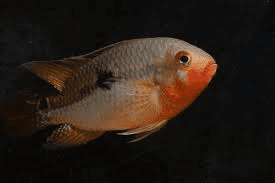
Common name: Saddle Cichlid, Two-Spot Acara, Tetramerus Cichlid
Scientific name: Aequidens Tetramerus
Average Adult Fish Size: 8 inches / 20 cm
Place of Origin: The Saddle Cichlid originates from the rivers, tributaries and flood plains of the northern South America and northern portions of the Amazon.
Typical Tank setup: Although the Saddle Cichlid will appreciate live plants, they are known to dig them up so strong roots and plenty of substrate is advised. Other than live plants it should be a typical South American cichlid arrangement with plenty of open swimming space as well as hiding places formed out of bogwood and rocks.
Recommended Minimum Aquarium Capacity: 60 gallon / 240 litre
Compatibility: The Saddle Cichlid should be kept with similar sized South American Cichlids.
Temperature: 74 – 84 Deg F / 24 – 29 Deg C
Water chemistry: pH 5.5 – 7.0
Feeding: The Saddle Cichlid should be fed a varied diet consisting of both plant based and meaty foods in order to provide them with all the vitamins and minerals they need to maintain a healthy immune system and slime coat. Hobbyists should provide a mix of quality Cichlid pellet foods mixed with freeze-dried or frozen preparations like bloodworms or other similar foods. Saddle Cichlids will also feed on blanched vegetables and planted based wafer or freeze-dried foodstuffs. They should be fed once or twice per day an amount of food that they will consume within a few minutes.
Sexing: Males grow larger than females and usually develop extensions to the unpaired fins as they mature. When in spawning condition the males are also the more colourful gender.
Breeding: Biparental substrate spawner and relatively simple to breed. The most proven method is to buy a group of 6 or more young specimens to be grown on together, removing the excess once pairs begin to form.
Additional Information: Water quality is of the utmost importance since these cichlids are susceptible to deteriorating water quality and should never be introduced to a biologically immature aquarium. The best way to achieve the desired stability is to over-filter the tank using a combination of external canister filters and/or a sump system and perform minimum weekly water changes of 50-70%. If the maintenance regime and/or diet is insufficient individuals may develop health problems such as head and lateral line erosion or exhibit stunted growth. Mechanical filtration should be tailored to trap small particles stirred up by the fish as sand can cause blockages/wearing issues with filter mechanisms if allowed to continually run through the system. High flow rates should be avoided so position filter returns accordingly.


Related Posts
Croaking Gourami – Trichopsis vittatus
Paradise Fish – Macropodus opercularis
Schubert’s Barb – Barbus Semifasciolatus